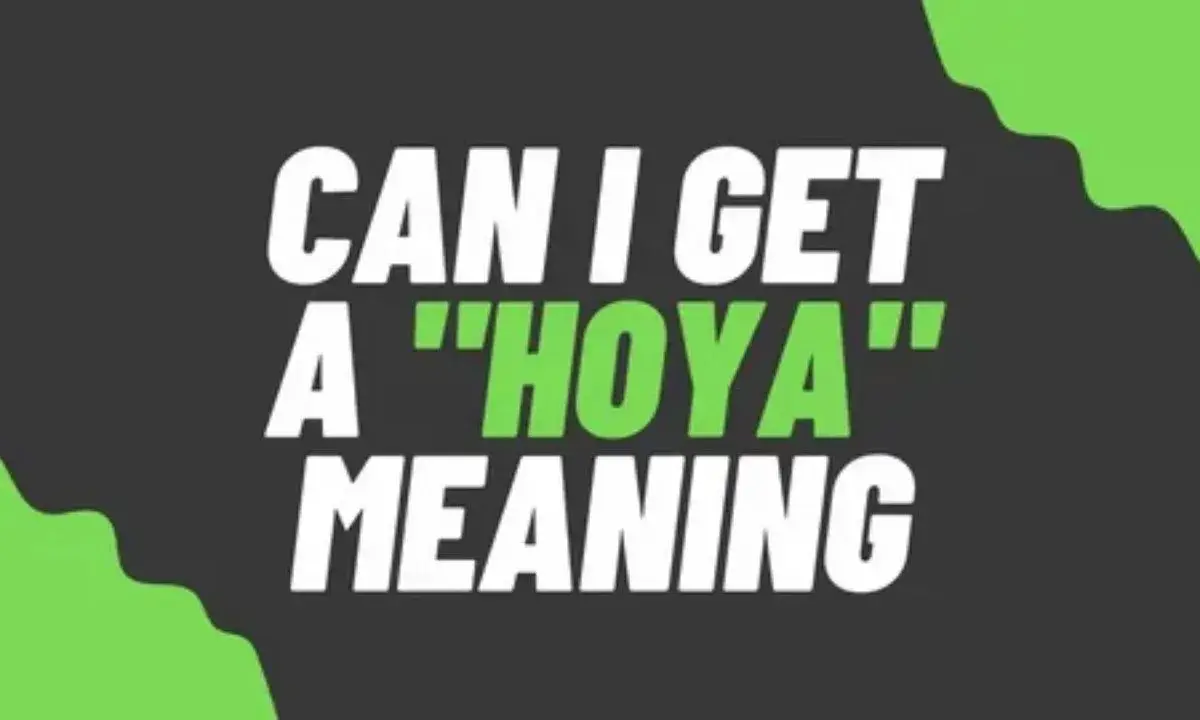The internet has a strange way of turning random sounds into global catchphrases. One of those phrases that has echoed through TikTok, Vine, and YouTube Shorts is “Can I get a Hoya?” Whether you’ve heard it yelled across a store, whispered into a camera, or screamed at a concert, you’ve probably wondered: What does it actually mean, and why does everyone keep saying it?
This phrase isn’t just a random internet meme — it’s a fascinating blend of wrestling culture, viral meme evolution, and modern social media humor. Let’s break it down.
What Does “Can I Get a Hoya?” Mean?
The Basic Definition
“Can I get a Hoya?” is a call-and-response phrase — a playful, often loud request for energy, enthusiasm, or acknowledgment from others.
Think of it like shouting, “Can I get a cheer?” or “Can I get an amen?” It’s designed to hype people up, encourage participation, or break awkward silence in a humorous way.
The “Hoya” itself doesn’t have a defined meaning. It’s more of a sound — an expressive, exaggerated vocalization that blends the tones of a cheer and a howl. That’s what makes it so versatile.
In internet slang terms, it’s a “hype expression” — something people say to provoke laughter, engagement, or just show off confidence online.
Tone & Delivery Matter
How you say “Can I get a hoya?” totally changes how it’s received.
- Shouted loudly → Seen as fun, bold, confident
- Whispered softly → Flirty or ironic
- Overused or awkwardly timed → Cringe or attention-seeking
For example, shouting it at a party might get the crowd hyped. Doing it in a quiet library? Not so much.
Tone sets the context. In internet meme culture, delivery is everything — and that’s exactly why this phrase exploded across platforms like TikTok and Vine.
Origin — Where Did “Can I Get a Hoya?” Come From?
Pro-Wrestling Roots
Before it became a meme, “Can I get a Hoya?” had loose roots in WWE (World Wrestling Entertainment) culture. Wrestling audiences are known for call-and-response chants — fans feeding energy to wrestlers through vocal hype.
Many internet historians link the phrase’s energy and cadence to Stone Cold Steve Austin’s famous “Can I get a hell yeah?!” rallying cry. Over time, fans mimicked and modified it — and eventually, it evolved into “Can I get a Hoya?” online.
It’s a linguistic mutation born from the same DNA: short, punchy, and perfect for audience participation.
Meme-Culture Mutation
The phrase didn’t hit the mainstream until Vine, the now-defunct 6-second video platform, brought it into internet folklore around 2014–2015.
One of the earliest known uses was a clip where someone shouted, “Can I get a Hoya?” in a public bathroom — only to have a stranger yell “HOYA!” back from another stall. The absurdity made it hilarious, and the clip exploded with millions of loops.
When TikTok launched, the meme resurfaced. It fit perfectly into short-form video culture — fast, repeatable, and easy to remix.
From Vine to TikTok, YouTube Shorts, and Instagram Reels, the meme kept evolving. Every platform added its twist, from ironic remixes to dance edits.
The Viral Snowball Effect
Why did this silly phrase spread so far? A few psychological and algorithmic reasons explain it:
| Factor | Explanation |
|---|---|
| Short & Repeatable | Easy to mimic; low effort but high engagement. |
| Interactive | Invites participation — anyone can reply “HOYA!” |
| Comedic Timing | Works as both a punchline and a setup. |
| Algorithm Boost | High duet/stitch engagement on TikTok amplified exposure. |
| Cross-platform adaptability | Works equally well in memes, pranks, or edits. |
According to Mashable, phrases like this thrive because they trigger social mimicry — people copy what gets laughs or views. The result? Millions of duets and responses tagged with #CanIGetAHoya.
Real-Life Use — When & How to Say It (or Not)
Appropriate Contexts
When used right, “Can I get a Hoya?” can lighten the mood, break tension, or hype people up. Here’s when it works:
- At parties or concerts – to boost group energy.
- At the gym – for a quick motivational shout between sets.
- Among friends – as an inside joke or meme reference.
- Retail or service interactions – lighthearted, viral shoutouts (think: “Retail shout heard round TikTok”).
- Online comments or livestreams – for playful engagement.
Essentially, any space where people understand meme culture is fair game.
Inappropriate or Awkward Contexts
Just because something’s funny online doesn’t mean it plays well offline. Some places to avoid:
- Workplaces – may come off as unprofessional or disruptive.
- Serious events – funerals, meetings, or ceremonies are a definite no.
- Public spaces – shouting randomly can disturb others or cause confusion.
- Around strangers – contextless humor can read as weird or immature.
A good rule of thumb: if you wouldn’t yell “Let’s gooo!” there, don’t yell “Can I get a Hoya?” either.
Case Study: The Retail Shout Heard Round TikTok
One of the most viral modern uses of the phrase came from a Target employee in 2020. In the clip, a shopper jokingly called out, “Can I get a Hoya?” across an aisle. Without missing a beat, the cashier yelled back, “HOYA!”
The video amassed over 7 million views and sparked a flood of copycats across retail chains.
It wasn’t just funny — it represented a moment of shared human humor between strangers.
This case became known as “The Retail Shout Heard Round TikTok”, proving that a simple meme could cross from digital screens into real-world moments.
Key insights from this viral moment:
- Humor thrives in unexpected, relatable settings.
- Participatory memes build community.
- Timing + authenticity = viral gold.
That one clip reminded everyone that internet humor isn’t confined to phones — it’s a cultural language.
Comparison With Similar Call-and-Response Expressions
Language evolves, and the internet constantly spins out new versions of hype expressions. Here’s how “Can I get a Hoya?” stacks up against others:
| Phrase | Origin | Common Context | Audience Reaction | Risk of Cringe |
|---|---|---|---|---|
| Can I get a Hoya? | Vine / TikTok | Meme, crowd hype | Fun, playful | Medium |
| Can I get an Amen? | Church culture | Agreement, support | Affirming | Low |
| Hooyah! | Military (Navy SEALs) | Motivation, unity | Respectful | Low |
| Yeehaw! | Southern US slang | Celebration | Joyful | Low |
| Let’s gooo! | Sports / meme slang | Excitement | Energetic | Medium |
The difference? “Can I get a Hoya?” lives primarily in internet subculture, not formal speech or regional dialect. It’s ironic, intentionally over-the-top, and thrives on shared meme awareness.
Pros and Cons of Using “Can I Get a Hoya?”
Pros
- Ice-breaker: It’s a lighthearted way to start a conversation or get attention.
- Crowd energy: Perfect for rallies, parties, or events needing hype.
- Cultural fluency: Shows you’re tuned into current internet slang.
- Social bonding: Creates shared laughter when the crowd responds.
- Algorithm advantage: Using trending phrases in captions or comments boosts visibility.
Cons
- Cringe potential: If said at the wrong time or with no response, it backfires.
- Misinterpretation: Older audiences or professionals may find it confusing or immature.
- Overuse fatigue: Like any meme, repetition kills the fun.
- Context-dependent: Works only when your audience gets the reference.
- Risk of workplace awkwardness: Not HR-friendly in corporate settings.
Bottom line: it’s all about reading the room.
FAQs — People Also Ask
Is “Can I get a Hoya?” appropriate to use at work?
Not usually. Workplaces require professionalism, and meme-based slang can seem immature. Unless your office has a casual, humor-friendly culture, skip it.
How do you respond to “Can I get a Hoya?”
The correct and classic response is to shout back: “HOYA!”
Online, people sometimes reply with emojis (🔥🙌😂) or humorous variations like “HOYAAA” or “HOYEEA!”
What does “Hoya” mean in slang?
In this context, “Hoya” doesn’t mean anything literal. It’s just a sound meant to mimic a cheer or excited yell — similar to “woo!” or “yeah!”
Is it spelled “Hoya” or “Hooyah”?
They’re not the same.
- Hoya = Meme phrase, playful, internet slang.
- Hooyah = Real military term used by US Navy SEALs to express agreement or motivation.
Confusing the two can lead to awkward misunderstandings.
Where did the phrase become popular first?
The first viral appearance traces back to Vine (2014–2015), later spreading to TikTok, Instagram Reels, and YouTube Shorts through remix trends.
Conclusion — So, Should You Shout “Can I Get a Hoya?”
“Can I get a Hoya?” isn’t just a sound — it’s a snapshot of how internet humor works. It started with wrestling energy, evolved through Vine absurdity, and reached immortality through TikTok virality.
If you’re in the right crowd, it’s pure gold — a call that connects strangers and friends through shared laughter. But used out of context, it can come off awkward or misplaced.
So should you shout it?
- At a concert or TikTok live? Absolutely.
- In a meeting or classroom? Probably not.
It’s not about what you say — it’s about when you say it.
Quick Takeaways
- “Can I get a Hoya?” = A meme-style call for hype or acknowledgment.
- Originated from wrestling-inspired meme culture, first viral on Vine.
- Revived by TikTok, with millions of uses under #CanIGetAHoya.
- Works best in fun, casual, or online environments.
- Not recommended in professional or serious contexts.
Quote: “Memes like ‘Can I get a Hoya?’ remind us that the internet isn’t just about content — it’s about connection through shared absurdity.”
Related Phrases to Explore
- “Yasss queen!” – expression of approval or hype.
- “Let’s gooo!” – excitement or success celebration.
- “Make some noise!” – concert-style call for energy.
- “Can I get an amen?” – traditional affirmation phrase.

Ember Clark is an expert blogger passionate about cartoons, sharing captivating insights, trends, and stories that bring animation to life for fans worldwide.

